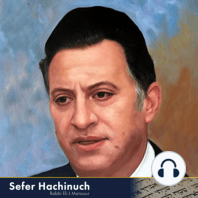20 min listen
Misva #131: Terumat Ha’deshen – Cleaning the Ashes From the Top of the Altar
FromSefer Hachinuch
ratings:
Length:
20 minutes
Released:
Feb 2, 2022
Format:
Podcast episode
Description
The opening verses of Parashat Sav (Vayikra, chapter 6) introduce the Misva of “Terumat Ha’deshen,” the daily ritual of removing ashes from the top of the altar. The Torah commands that the Kohen must wear his special priestly garments, walk up the ramp to the top of the altar, and remove ashes that had collected. The Sefer Ha’hinuch writes that the purpose of this Misva is to maintain the beauty and grandeur of the Bet Ha’mikash. Before the Kohanim begin offering sacrifices each morning, they must first clean the surface of the altar so that G-d’s “table,” so-to-speak, would be clean. Just as we do not eat on a dirty table, it is likewise appropriate to first ensure to clean the top of the altar each morning before proceeding to offer sacrifices to G-d. Secondly, the Sefer Ha’hinuch adds, fire burns stronger on a surface that is clean of ashes, and so the ashes were removed each morning so that the fire on the altar would burn properly. While we might have intuitively thought that Terumat Ha’deshen is nothing more than custodial work, the Sages teach that it had the status of a formal “Aboda” (service). As such, the Kohen who performed the Terumat Ha’deshen needed to wear his Bigdeh Kehuna (priestly vestments), and could not carry out this duty wearing ordinary clothes. However, the Gemara teaches that the Kohen would wear lower quality garments (“Begadim Pehutim”), as it would be inappropriate to wear the same clothing while cleaning the altar and while performing the other rituals. Nevertheless, even these lower quality garments needed to be formal Bigdeh Kehuna. The Terumat Ha’deshen was performed each morning at Alot Ha’shahar – daybreak. On the three Regalim (pilgrimage holidays – Pesach, Shabuot and Sukkot), however, it was performed earlier, during the last third of the night. The reason is that the pilgrims offered sacrifices on the Regalim when they visited the Bet Ha’mikdash, and there was thus a large amount of ashes to remove at these times. Hence, the Terumat Ha’deshen began earlier. On Yom Kippur, when the Kohen Gadol performed the entire service, the Terumat Ha’deshen took place already at Hasot (midnight as defined by Halacha). It was done then to give the Kohen time to rest before proceeding to perform the rest of the day’s service. A “Payis” (lottery) was held each morning to determine which of the Kohanim who were on duty would have the privilege of performing the Terumat Ha’deshen. The chosen Kohen would immerse in a Mikveh, don his Bigdeh Kehuna, wash his hands and feet from the Kiyor (the special faucet in the Temple courtyard), and then take a silver shovel and walk up the ramp to the top of the Mizbe’ah (altar). He would move the coals around the altar with the shovel, and then fill the shovel with ashes from the area where the most ashes had collected. He would walk down the ramp to the ground, and then walk northward for ten Amot along the eastern side of the altar. He reached a site three Tefahim (handbreadths) away from the ramp to the altar where he would place the ashes. Afterward, other Kohanim would ascend the ramp to the top of the altar to do maintenance work – sweeping the ashes into a large pile in the center of the altar, which was called the “Tafuah.” Every so often, when this pile became very large, a Kohen would go to the top of the altar with a special, large utensil called the “Pesachter” to remove this pile of ash and bring it outside the Bet Ha’mikdash, where it was discarded. This process is called “Hosa’at Ha’deshen.” Rav Samson Raphael Hirsch (Germany, 1808-1888) offers an especially meaningful explanation for the daily ritual of Terumat Ha’deshen. He suggested that the daily shovel’s worth of ashes removed from the altar parallels Kemisa – the handful of grain that was taken from the Minha (flour offering) and placed on the fire on the altar. The purpose of the daily removal of ashes, Rav Hirsch explained, was to remind the people that each day’s sacrifices were continuing the p
Released:
Feb 2, 2022
Format:
Podcast episode
Titles in the series (100)
Misva #19: The Prohibition Against Eating Hametz on Pesach: Daily Sefer Hachinuch - Brought to you by itorah.com by Sefer Hachinuch
